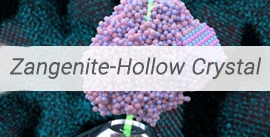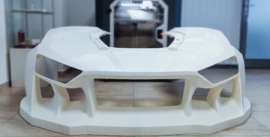 جدید
جدیدسختترین سرامیک شفاف پس از الماس، برای اولین بار سنتز شد!! Scientists Synthesize First Sample of Transparent Si3N4 Ceramics
سرامیک شفاف
سختترین سرامیک شفاف پس از الماس، برای اولین بار سنتز شد!!
Scientists Synthesize First Sample of Transparent Si3N4 Ceramics
اولین نمونهی شفاف از یک سرامیک صنعتی شناخته شده، توسط دانشمندان در DESY سنتز شده است. در گزارش چاپ شده از این پژوهش در ژورنال Scientific، این گروه ژاپنی-آلمانی مینویسد که این ماده یک پنجرهی بسیار سخت ساخته شده از نیترید سیلیسیوم مکعبی با پتانسیل کاربرد در شرایط سخت مانند کاربردهای مهندسی میباشد.
——————————————————–
ترجمه از گروه ترجمه ایران مواد
حرفه ای ترین تیم ترجمه مهندسی مواد کشور
———————————————————
نیترید سیلیسیوم مکعبی(c-Si3N4) که تحت فشار بسیار زیاد عمل آمده است، دومین نانوسرامیک شفاف سخت پس از الماس میباشد اما پایداری و مقاومت حرارتی بیشتری نسبت به الماس دارد.
نیترید سیلیسیوم یک سرامیک بسیار معروف و پرکاربرد در صنعت میباشد. این ماده در اصل برای بلبرینگها، ابزار برش و اجزای موتور در خودروها و هواپیماها به کار گرفته میشود.
از آنجایی که پیوندهای نیتروژن و سیلیسیوم بسیار بسیار قوی میباشد، این سرامیک بسیار پایدار میباشد. در فشارهای میحط، نیترید سیلیسیوم دارای ساختار بلوری هگزاگونال بوده و بدنهی زینترشدهی آن، اپک میباشد. برای زینتر این مواد نیز روشهای بسیار گستردهای در صنعت مورد استفاده میباشد.
در فشارهای بالای ۱۳۰ هزار برابر فشار اتمسفر، ساختار نیترید سیلیسیوم به مکعبی تغییر یافته که از گونههای ساختارهای اسپینلی میباشد. اسپینل مصنوعی(MgAl2O4) به طور گستردهای به عنوان سرامیک شفاف در صنعت مورد استفاده قرار میگیرد.
دکتر Nishimiysra، دانشیار انستیتوی تکنولوژی توکیو در این باره میگوید: “نیترید سیلیسیوم مکعبی برای اولین بار توسط گروه پژوهشی در دانشگاه Darmstadt در سال ۱۹۹۹ سنتز شده است اما دانش این ماده بسیار محدود میباشد.”
تیم پژوهشی دکتر Nishiyama در DESY برای اعمال فشار و دماهای بالا از یک پرس با حجم بزرگ(LVP) استفاده کردند. در حدود فشار ۱۵۶ هزار برابری فشار اتمسفر (GPa 6/15) و دمای ۱۸۰۰ درجه سانتی گراد، یک تکه نیترید سیلیسیوم مکعبی با قطر تقریبی mm 2 حاصل شد. Nishiyama تاکید کرده است که: “این، اولین نمونه از نیترید سیلیسیوم شفاف میباشد”.
بررسیهای ساختار بلوری در مرکز اشعهی ایکس DESY نشان داده است که، کل ساختار نیترید سیلیسیوم تبدیل به فاز مکعبی شده است.
تبدیلات ساختاری این ماده نیز مانند کربن میباشد که در شرایط محیطی دارای ساختار هگزاگونال(گرافیت) میباشد و در فشارهای بالا تبدیل به ساختار مکعبی شفاف به نام الماس میشود. در هر حال، میزان شفافیت نیترید سیلیسیوم وابسته به مرزدانههای آن میباشد. میزان اپک بوده و کدری با افزایش حفرات و فاصلهی بین دانهها، افزایش مییابد.
دکتر Nishiyama میگوید: “آنالیز نمونه با استفاده از TEM در دانشگاه توکیو، حاکی از آن است که نمونهی فشار بالا تنها دارای مرزدانههای بسیار باریک میباشد. همچنین در فاز فشار بالا، ناخالصیهای اکسیژن در کل ماده پخش شده و مانند فاز فشارپایین در مرزدانهها انباشته نشدهاند. این خواص برای شفافیت بسیار حیاتی و مهم میباشد.”
Nishiyama در ادامه توضیح داد که: “نیترید سیلیسیوم مکعبی سختترین و محکمترین سرامیک اسپینلی شفاف تاکنون ساخته شده میباشد. دانشمندان کاربرد آن در صنایع مختلف به عنوان پنجرههای بسیار سخت را پیشبینی کردهاند. نیترید سیلیسیوم شفاف، پس از الماس و نیترید بور، سومین مادهی سرامیکی سخت میباشد. مزیت این ماده نسبت به الماس و نترید بور این است که، ترکیبات بور شفاف نبوده و پایداری دمایی الماس در هوا نیز تنها تا ۷۵۰ درجهی سانتی گراد میباشد. نیترید سیلیسیوم مکعبی، هم شفاف میباشد و هم تا دمای ۱۴۰۰ درجهی سانتی گراد پایدار میباشد.
با این حال به دلیل فشار بسیار بالای مورد نیاز برای سنتز نیترید سیلیسیوم مکعبی، به دلایل و محدودیتهای عملی، ابعاد پنجرههای ساخته شده از آن محدود خواهد بود.
مادهی اولیهی آن ارزان میباشد اما برای تولید نمونههای ماکروسکوپی نیترید سیلیسیوم مکعبی به فشار تقریبا ۲ برابر فشار مورد نیار برای سنتز الماس، نیاز داریم. ساخت پنجرههایی با ابعاد ۱ تا ۵ میلیمتر به سادگی امکانپذیر میباشد ولی رسیدن به اندازههای بالای ۱ سانتیمتر نیز بسیار دشوار میباشد.
منبع: www.azom.com
مترجم : امیر اشجاری
Scientists Synthesize First Sample of Transparent Si3N4 Ceramics
The first transparent sample of a well-known industrial ceramic has been synthesized by scientists at DESY. In the journal Scientific Reports, the Japanese-German team writes that the outcome is a super-hard window made of cubic silicon nitride capable of potentially being used under severe conditions like that in engines.
Cubic silicon nitride (c-Si3N4) that develops under high pressure is treated to be the second hardest transparent nanoceramic after diamond but can survive substantially higher temperatures.
Silicon nitride is a very popular ceramic in industry. It is mainly used for ball bearings, cutting tools and engine parts in automotive and aircraft industry.
The ceramic is very stable, as the silicon nitrogen bond is extremely strong. At ambient pressures, silicon nitride consists of a hexagonal crystal structure and sintered ceramic of this phase is opaque. Sintering is the process of developing macroscopic structures from grain material using pressure and heat. The method is extensively used in industry for products ranging from ceramic bearings to artificial teeth.
At pressures of more than 130 thousand times the atmospheric pressure, silicon nitride changes into a crystal structure with cubic proportion that experts refer to as spinel-type in reference to the structure of a common gemstone. Artificial spinel (MgAl2O4) is extensively used as transparent ceramic in industry.
The cubic phase of silicon nitride was first synthesised by a research group at Technical University of Darmstadt in 1999, but knowledge of this material is very limited,” says Nishiyama.
His team used a large volume press (LVP) at DESY to subject hexagonal silicon nitride to high temperatures and pressures. At about 156 thousand times the atmospheric pressure (15.6 GPa) and a temperature of 1800 °C, a transparent piece of cubic silicon nitride was created with a diameter of approximately 2 mm. “It is the first transparent sample of this material,” emphasizes Nishiyama.
Investigation of the crystal structure at DESY’s X-ray light source PETRA III revealed that the silicon nitride had totally transformed into the cubic phase.
The transformation is similar to carbon that also has a hexagonal crystal structure at ambient conditions and transforms into a transparent cubic phase called diamond at high pressures. However, the transparency of silicon nitride strongly depends on the grain boundaries. The opaqueness arises from gaps and pores between the grains.
Analysis with a scanning transmission electron microscope at the University of Tokyo revealed that the high-pressure sample has only extremely thin grain boundaries. “Also, in the high-pressure phase oxygen impurities are distributed throughout the material and do not accumulate at the grain boundaries like in the low-pressure phase. That’s crucial for the transparency,” says Nishiyama.
“Cubic silicon nitride is the hardest and toughest transparent spinel ceramic ever made,”summarizes Nishiyama. The scientists predict varied industrial applications for their super-hard windows. “Cubic silicon nitride is the third hardest ceramic known, after diamond and cubic boron nitride,” explains Nishiyama. “But boron compounds are not transparent, and diamond is only stable up to approximately 750 degrees Celsius in air. Cubic silicon nitride is transparent and stable up to 1400 degrees Celsius.”
However, due to the large pressure required to synthesize transparent cubic silicon nitride, the possible window size is restricted for practical reasons.
The raw material is cheap, but to produce macroscopic transparent samples we need approximately twice the pressure as for artificial diamonds. It is relatively easy to make windows with diameters of one to five millimetres. But it will be hard to reach anything over one centimetre.









دیدگاه کاربران